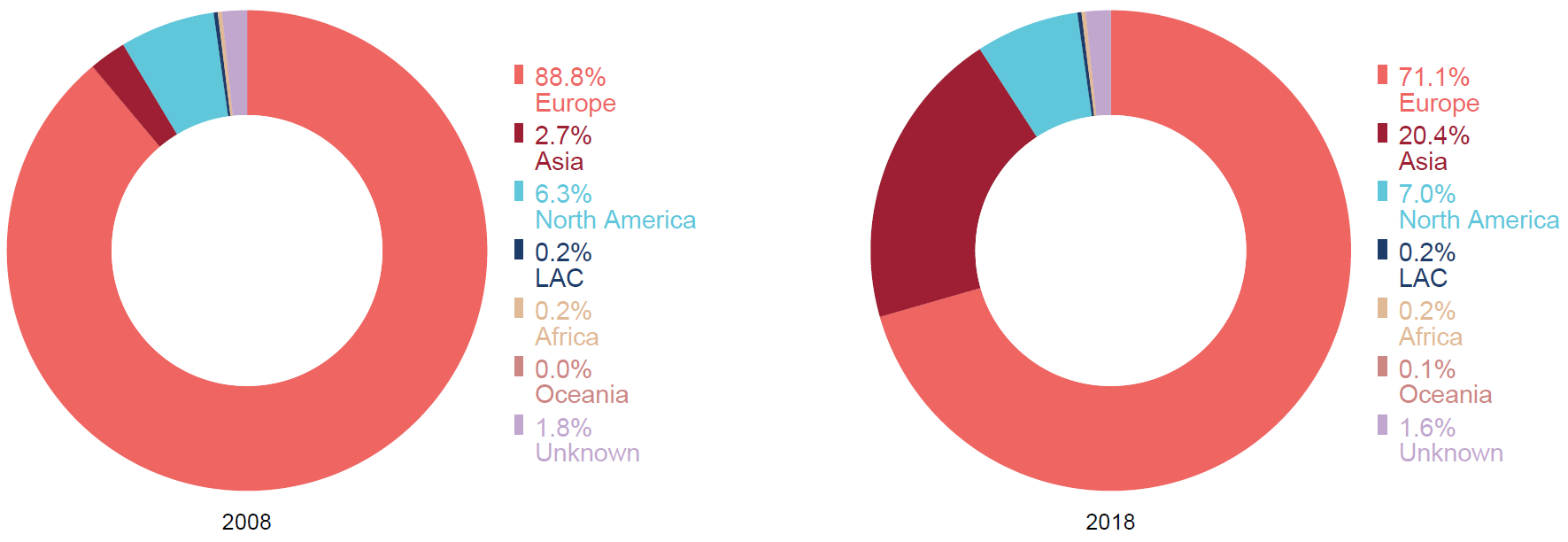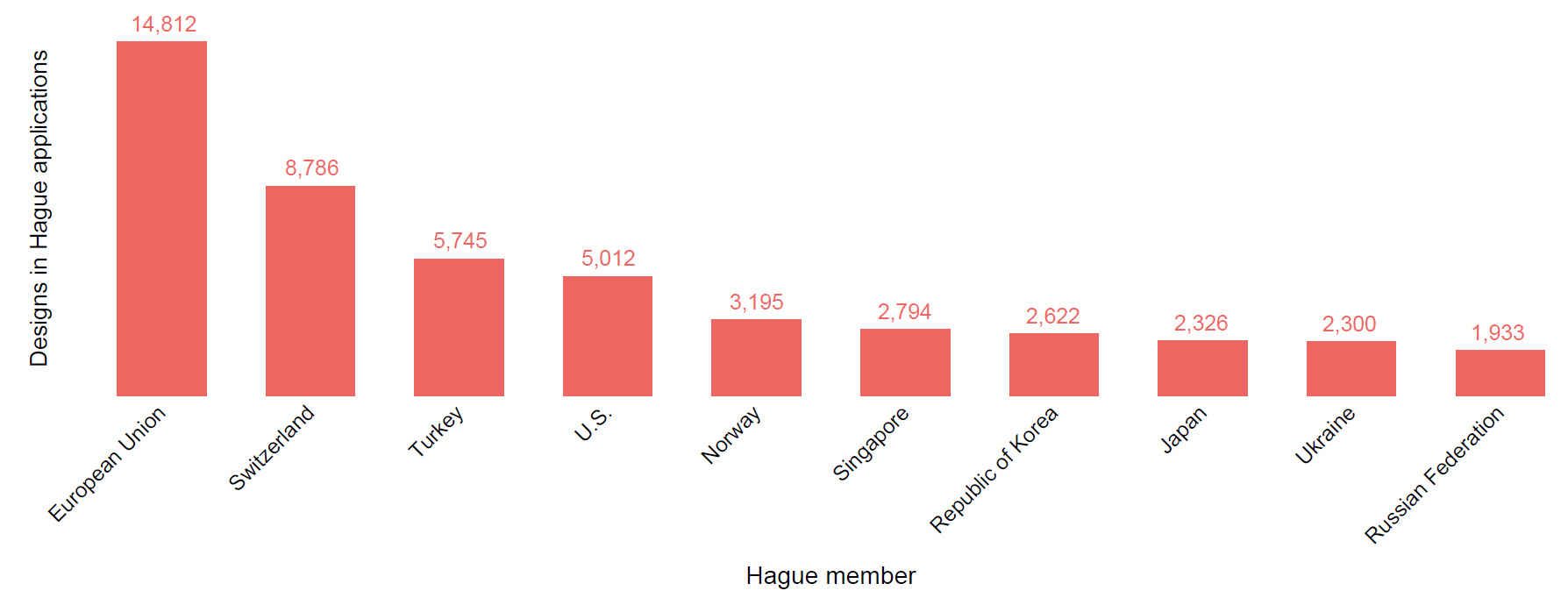23/09/2019
The World Intellectual Property Office (WIPO) has recently released its annual review of registered design applications filed under the Hague System. Click here to read the report covering applications filed in 2018.
The Hague System is a series of treaties administered by WIPO and concerns the international registration of industrial designs in up to 88 countries. The Hague System is therefore somewhat similar to the PCT for patents and the Madrid System for trade marks.
Applicants use the Hague System because it is a relatively simple process that allows for protection of an industrial design in multiple jurisdictions by filing a single international application. Consequently, use of the Hague System avoids the time-consuming process of filing separate applications before each national or regional intellectual property office. A Hague System application also allows for simplified management of an international portfolio of registered designs because the international application is handled through a single institution, WIPO.

Trend in the number of Hague international applications filed, 2004-2018.
Source: WIPO (2019), Hague Yearly Review 2019: International Registration of Industrial Designs, Geneva: WIPO.
The report released by WIPO shows that approximately 5,429 Hague System applications were filed in 2018, which is an increase of 3.3% from 2017. For reference, the EUIPO received over 26,000 registered Community design applications in the same period. Although there was an increase in the number of Hague System applications filed in 2018, the number of designs contained in Hague System applications actually fell by 2%, following 11 years of uninterrupted growth. This contrast can be partly explained by applications from newer members of the Hague System, such as Japan and South Korea, having fewer designs per application than applications from the traditional top filers, such as Germany and Switzerland.
Applicants from Germany filed for protection of more designs under the Hague System in 2018 than users from any other country, as has been the case for 33 consecutive years. This contributed to applicants based in Europe filing 71.1% of all designs. This high percentage can be partly explained by the majority of Hague System members being European countries, and the Hague System being a well understood scheme in Europe

Designs contained in Hague System applications by region, 2008 and 2018.
Source: WIPO (2019), Hague Yearly Review 2019: International Registration of Industrial Designs, Geneva: WIPO.
The proportion of designs filed by Asian applicants is however increasing as more Asian countries join the Hague System. As the Figure above shows, the share of designs filed by applicants from Asian countries has increased from 2.8% in 2008 to 20.4% in 2018, with Japan and South Korea joining the Hague System in that time. The proportion of designs filed by applicants from Asian countries is expected to continue to rise in the future, especially if China joins the Hague System in due course (see below).
Closer to home, applicants from the UK recorded a steady 6.5% increase in the number of Hague System applications filed in 2018, along with a 5.5.% increase in the number of designs included in Hague System applications. These increases could perhaps be due to the publicity given to the Hague System when the UK joined as a separate member to the EU in 2018. Despite these increases, the data released by WIPO shows that the Hague System remains underused by UK applicants when compared to their counterparts from continental Europe.
The report reveals that Samsung Electronics has maintained its spot as the top Hague System applicant, with LG Electronics coming in second. However, the top Hague System applicants are not limited to just electronics companies. The top 10 applicants has some established names and includes the likes of consumer goods multinational Proctor & Gamble (3rd), automotive manufacturer Volkswagen (7th) and watchmaker Swatch (8th). Indeed, designs relating to furnishing accounted for the largest share of all designs filed under the Hague System in 2018, with 12.1%.

Hague System designations for the top 10 designated Hague members, 2018.
Source: WIPO (2019), Hague Yearly Review 2019: International Registration of Industrial Designs, Geneva: WIPO.
A Hague System applicant can choose to protect their design with up to 70 designated members, covering 88 countries. The applicant must select their chosen designated members on filing and additional members cannot normally be added post filing. WIPO’s report shows that the EU is still the most popular designated member in terms of number of designs, as it has been since 2010. Notably, there was an 8.5% increase in the number of designs contained in US designations. This may be a sign that Hague System applicants are becoming more comfortable with including the US as a designated member rather than seeking design protection with a separate national application.
Although the data shows that the Hague System is becoming increasingly popular over time, the number of applications filed through the Hague System is still significantly lower than the number of registered design applications filed at many national or regional intellectual property offices. One factor that may be discouraging use of the Hague System is its coverage. Although the Hague System now has 70 members covering 88 countries, major manufacturing bases such as China and India are not members of the System.
A sticking point in China joining the Hague System is that the term of a Chinese registered design is currently lower than the minimum duration required under the Hague System. However, amendments to Chinese IP law are currently being considered, which would see the term of a Chinese registered design increase from 10 years to 15 years, the minimum required by WIPO. Indeed, earlier this year at the 15th China International Design Expo, Commissioner Shen Changyu of the China National Intellectual Property Administration revealed that discussions with WIPO are ongoing. The Hague System may prove to be much more attractive to applicants once China becomes a member, so the number of Hague System applications being filed annually is set to keep increasing.
If you would like to discuss the advantages of protecting the design of your products, or for more information about Hague System applications and other forms of intellectual property protection, please contact us.
This article is for general information only. Its content is not a statement of the law on any subject and does not constitute advice. Please contact Reddie & Grose LLP for advice before taking any action in reliance on it.


